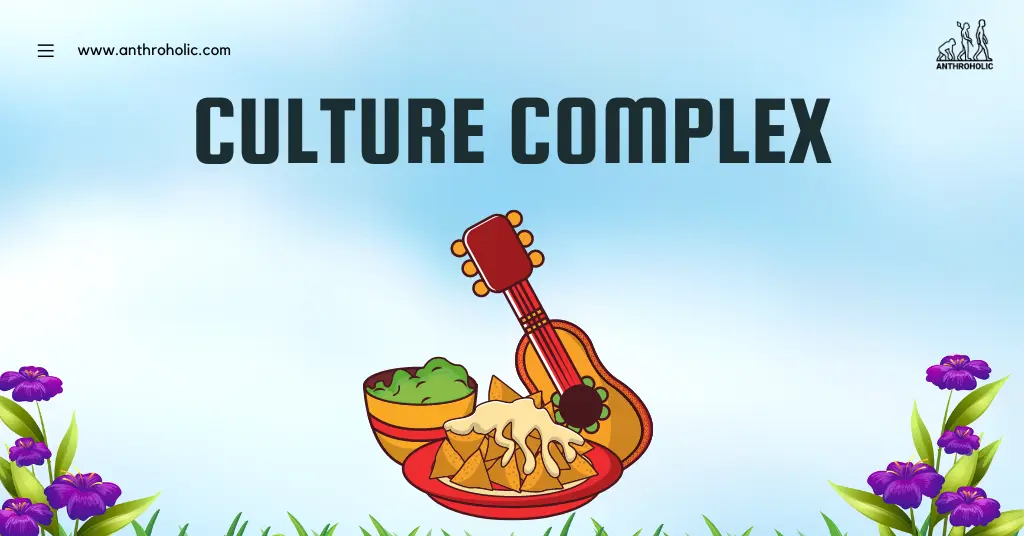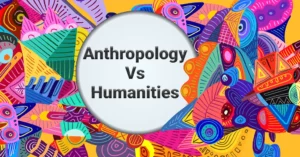AI Answer Evaluation Platform Live Now. Try Free Answer Evaluation Now
Culture Complex
Culture complex is a concept used to illustrate a constellation of related cultural traits. These can be anything from material objects, ideas, practices, and shared understanding. Culture complexes cluster around crucial aspects of social life such as cooking, hunting, or family structures [1].

Key Elements of Culture Complex:
- Shared Symbols: These are signs, objects, or gestures that carry a particular meaning within the cultural complex.
- Practices: These are recurring activities performed by individuals or groups.
- Values and Norms: These are collectively held beliefs about what is considered right, acceptable, or desirable.
- Material Artifacts: These are physical objects created and valued by the culture.
Example of Culture Complex:
The “Football Culture Complex” in many parts of the world involves elements such as the game itself (practice), team logos and colors (symbols), sportsmanship (values), and stadiums and jerseys (material artifacts).
Table 1: Culture Complex Elements
| Element | Example: Football Culture Complex |
|---|---|
| Shared Symbols | Team logos and colors |
| Practices | The game itself |
| Values and Norms | Sportsmanship |
| Material Artifacts | Stadiums and Jerseys |
Dynamics of Culture Complex
The culture complex is not static. It evolves with time due to the influence of several factors including:
- Cultural Diffusion: This is the spread of cultural items—such as ideas, styles, religions, technologies, languages—between individuals, either within a single culture or from one culture to another [2].
- Cultural Innovation: This involves the discovery of new ideas or the reinterpretation of old ideas in a way that impacts cultural practices [3].
- Cultural Integration: This is the process by which various parts of a culture are made consistent with each other. It’s how a new cultural trait is fitted into the existing cultural framework [4].
- Cultural Adaptation: This is the process by which a culture modifies itself to become better suited to its environment [5].
Applying the Culture Complex
Culture complex plays a crucial role in our daily life. It not only influences our behavior and decision-making but also impacts societal structures and systems. For example, a “Wedding Culture Complex” in any society might influence social relationships, economic transactions, and even the legal system (in terms of marriage laws). By understanding culture complex, we can gain insight into group behavior and societal trends [6].
In Societal Structures
Different societies have different culture complexes that guide their social structure. For instance, the caste system in India, the class system in the United Kingdom, and the tribal system in African countries, are all rooted in distinct culture complexes [7].
In Consumer Behavior
Understanding the culture complex of a certain demographic can help marketers better appeal to their target audience. For example, knowing the “Teenage Pop Culture Complex” involving music, fashion, language, and social media trends can help a brand formulate successful marketing strategies.
In Social Change
The evolution of culture complexes can lead to significant social changes. For example, the increasing global “Digital Culture Complex” with elements such as internet use, digital devices, online communication norms, and values like open access, has transformed how we work, learn, and connect with others.
Theoretical Underpinnings of Culture Complex
Theoretical formulations of culture complex provide significant insights into the workings of society and culture. Two key theories – cultural relativism and functionalism – serve as critical perspectives in understanding culture complex.
Cultural Relativism
Cultural relativism suggests that an individual’s beliefs and activities should be interpreted in terms of their own culture. This principle was established as an axiom in anthropological research by Franz Boas in the early 20th century and later expanded by his students [8].
In terms of culture complex, cultural relativism posits that we can’t apply the norms and values of one culture complex to another. For example, a western “Fast Food Culture Complex” involving quick service, convenience, and food-on-the-go can’t be evaluated from the perspective of a traditional “Slow Food Culture Complex” in certain parts of Asia or Europe that prioritize leisurely dining, communal meals, and home cooking.
Functionalism
Functionalism, advanced by anthropologists such as Bronislaw Malinowski and A. R. Radcliffe-Brown, views society as a complex system whose components work together to promote solidarity and stability. Culture complexes can be seen as parts of this system, each serving a specific function to maintain the overall social equilibrium [9].
For instance, the “Religious Culture Complex” in many societies provides moral guidance, emotional support, and a sense of community, thereby promoting social cohesion and stability.
Culture Complex in the Modern World
The advent of globalization and digital technology has led to an ever-increasing interconnectedness between different culture complexes worldwide. This phenomenon has implications for cultural homogenization, hybridity, and resistance.
Cultural Homogenization
Cultural homogenization is the process by which different cultures become increasingly similar or homogeneous. It often happens due to the dominance of Western culture complexes, like the “Fast Food Culture Complex” or “Digital Culture Complex,” which spread globally through media, technology, and trade [10].
Cultural Hybridity
Alternatively, the collision of different culture complexes can also result in cultural hybridity – the blending of elements from different cultures. A classic example is the fusion of Western fast food with local culinary traditions, leading to items like “Sushi Pizza” or “Tandoori Chicken Burger.”
Cultural Resistance
Sometimes, societies consciously resist the influence of foreign culture complexes to preserve their indigenous cultural identity. For example, Bhutan’s policy to maintain its unique “Buddhist Culture Complex” limits the influence of Western culture complexes on its society [11].
| Phenomenon | Description | Example |
|---|---|---|
| Cultural Homogenization | Different cultures become increasingly similar | Global spread of “Fast Food Culture Complex” |
| Cultural Hybridity | Blending of elements from different cultures | “Sushi Pizza” |
| Cultural Resistance | Societies resist the influence of foreign culture complexes | Bhutan’s preservation of its “Buddhist Culture Complex” |
Conclusion
Culture complex is a lens through which we can examine how different elements of a culture are interwoven around specific aspects of social life. It plays a vital role in shaping societal structures, influencing consumer behavior, and driving social change. As our world becomes more interconnected, understanding culture complexes of not only our own society but also others’ becomes increasingly important. This comprehension can foster greater empathy, enhance communication, and ultimately, contribute to a more inclusive global society.
References
[1] Kottak, Conrad Phillip. (2005). “Window on Humanity: A Concise Introduction to General Anthropology”.
[2] Rogers, Everett M. (2003). “Diffusion of Innovations”.
[3] Schumpeter, Joseph A. (1942). “Capitalism, Socialism and Democracy”.
[4] Malinowski, Bronislaw. (1945). “The Dynamics of Culture Change: An Inquiry into Race Relations in Africa”.
[5] Bates, Daniel G., and Plog, Fred. (1990). “Cultural Anthropology”.
[6] Geertz, Clifford. (1973). “The Interpretation of Cultures”.
[7] Barth, Fredrik. (1956). “Ecological Relationships of Ethnic Groups in Swat, North Pakistan”.
[8] Boas, Franz. (1887). “Museums of Ethnology and their classification”.
[9] Radcliffe-Brown, A. R. (1952). “Structure and Function in Primitive Society”.
[10] Tomlinson, John. (1991). “Cultural Imperialism: A Critical Introduction”.
[11] Ura, Karma. (2004). “The Hero with a Thousand Eyes”.




